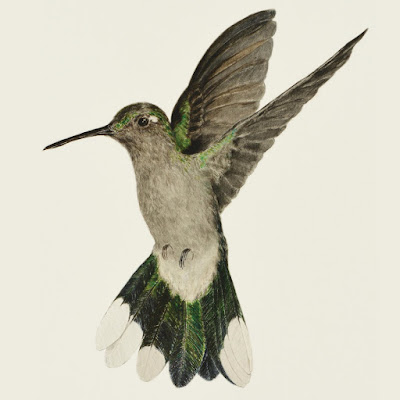 |
Dry-forest Sabrewing | Campylopterus calcirupicola
Lopes, de Vasconcelos & Gonzaga, 2017
FIGURE 7. The newly described Campylopterus calcirupicola from eastern Brazilian tropical dry forests.
watercolor painting by Walter Gam || DOI: 10.11646/zootaxa.4268.1.1
|
Abstract
A new species of Campylopterus sabrewing is described from eastern Brazilian tropical dry forests occurring below 900 m asl. Its holotype (MZUSP 99024) is an adult female from Sítio Duboca (16°43’19’’S, 43°58’20’’W, elevation 840 m), municipality of Montes Claros, state of Minas Gerais. A taxonomic revision based on more than 1,000 museum specimens revealed that the new taxon, together with C. largipennis, C. diamantinensis and C. obscurus (with C. aequatorialis considered as a subjective junior synonym) should be ranked as species. We provide a key to permit easy identification of the four species. The new species is very similar to the parapatric C. diamantinensis of high altitude “campos rupestres” above 1,000 m asl, differing from it by its smaller size and longer light tail tips, as well as by sternum measurements. Given the several threats faced by the habitat to which the new species is endemic, we propose to consider it as Vulnerable under the IUCN criteria.
Keywords: cryptic biodiversity, Neotropical, Trochilidae, tropical dry forests, Aves
 |
| A young male of Campylopterus calcirupicola captured on 18 July 2006 in the Fazenda Corredor (880 m asl), municipality of Bocaiúva, Minas Gerais, Brazil (DZUFMG 5005). Photographs by LEL. |
Campylopterus calcirupicola sp. nov. Dry-forest Sabrewing (English)
Asa-de-sabre-da-mata-seca (Portuguese)
Etymology. The name calcirupicola is Latin, composed by “calx”, calcis, limestone; “rupes”, steep rocks; and “cola”, dwelling (Eggli & Newton 2004). It refers to the habitat of this new hummingbird, which inhabits dry forests growing on limestone outcrops. This specific name matches that for the cactus Cereus calcirupicola F. Ritter, found in the type locality and in the same habitat (Ritter 1979) of the new hummingbird. The vernacular names we propose also refer to the habitat used by the new species.
Geographic distribution. Campylopterus calcirupicola has been recorded from Divinópolis de Goiás (northeastern state of Goiás) and Coribe (southwestern state of Bahia) to Bocaiúva (northern state of Minas Gerais) on both banks of the São Francisco River, as well as in the Paranã River valley, an important tributary of the Tocantins River, west of the Serra Geral (Figures 9 and 10). The altitudinal range of this new species is between 460–880 m asl. The range of C. calcirupicola probably extends to southeastern Tocantins (Dornas et al. 2014) and the southern part of the state of Piauí (Santos 2004), from where there are sight records of C. largipennis. We believe that the specimen of C. largipennis from “Posse, Goiás” cited by Silva (1990) as housed in the MNRJ refers to the specimen from “Galheiros” housed in the same institution and mentioned by Ruschi (1951), probably representing a toponymic mistake committed by Silva (1990).
Leonardo E. Lopes, Marcelo F. De Vasconcelos and Luiz P. Gonzaga. 2017. A Cryptic New Species of Hummingbird of the Campylopterus largipennis complex (Aves: Trochilidae). Zootaxa. 4268(1); 1–33. DOI: 10.11646/zootaxa.4268.1.1
CONHEÇA CARAMUJO E BEIJA-FLOR DESCOBERTOS POR CIENTISTAS DE MINAS